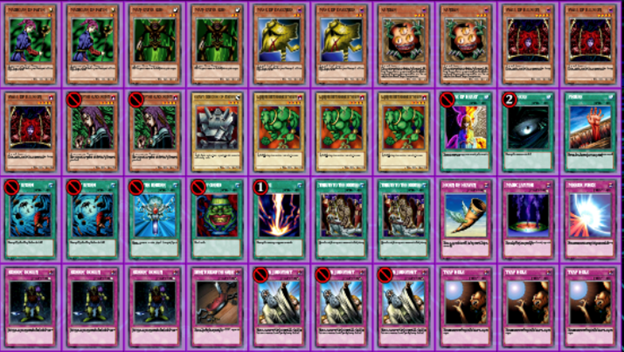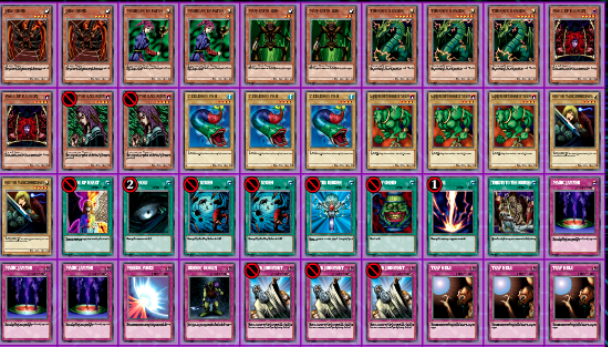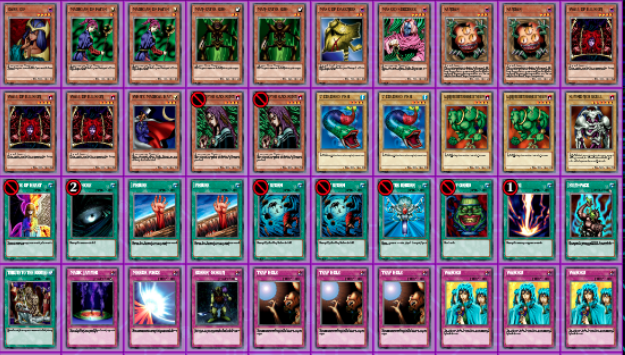|
|
|||||
| Pojo's Yu-Gi-Oh! news, tips, strategies and more! | |||||
|
|
|||||
 |
|||||
|
Card Game Featured Writers Releases + Spoilers Anime Video Games Other
Magic
This Space |
Baneful's Column [July 2002] Critter Format Guide Metal Raiders expanded upon the Yugi-Kaiba format. While still very basic, more power triangles were added to the mix. While decks in Critter Format still share most of the same cards, there is more room for customization. It’s a classic nostalgia format, before the slew of powerful Magic Ruler spells, yet more intellectually stimulating than the Yugi-Kaiba format. The Basics of Critter Format Card Pool: Starter Deck Yugi/Kaiba, Legend of Blue-Eyes (LOB), Metal Raiders (MRD). Limited Cards – Change of Heart, Dark Hole, Monster Reborn, Pot of Greed, Raigeki, Exodia Pieces. Semi-Limited Cards – Sangan, Witch of the Black Forest, Card Destruction, Heavy Storm, Swords of Revealing Light. Mechanicalchaser was released two months into the format, but it was extremely rare, few people played it and modern Critter Format does not include these builds. I’ll note the two most apparent ways this format builds upon Yugi-Kaiba: ˇ Heavy Storm at 2 means that Spells/Traps needs to be played conservative. ˇ Witch of the Black Forest and Sangan both at 2 means that monster removal needs to be used more discriminately. The Decks These are the basic deck types in Critter Format. I’ll give a general overview followed by more detailed discussion on the individual cards. Tempo – This deck focuses on defense, blocking the opponent’s attacks and then punishing. It uses removal via spells/traps and relies less on battle. But once the opponent’s life points are vulnerable, small monsters wear it down. The central card is Robbin’ Goblin, which makes high DEF monsters deadly and turns the Flip Effects floaters into mini White Magical Hats!
Aggressive Beatdown – This deck focuses on raw offense, with strong traps to protect it. In this build, Thunder Dragon is used to fuel Magic Jammer (protecting against Raigeki and other power spells), but I may just mull using Seven Tools of the Bandit and replace the Thunder Dragons with more cards that add more pressure.
Balanced Beatdown – This deck has a little bit of everything: offense, defense, control. Not bad for tutorial purposes. It’s probably the closest thing to tournament winning decks at the time.
Monsters Monsters in this format can be divided into 7 types: 1) Tributes – Have high ATK but require a sacrifice and can be dead in hand. Summoned Skull is the only viable tribute monster in the format. Summoned Skull has increased viability considering that it can use Critters (Witch/Sangan) as a “free” tribute, but deck space is tighter and consistent hands are more essential than in Yugi-Kaiba. 2) Beaters – La Jinn is still the king LV4 vanilla at 1800 ATK. The release 7 Colored Fish as the 2nd 1800 ATK monster means that any vanilla with less than 1800 ATK (like Ox and Neo) are instantly obsolete. While you could run Ox and Neo, it would come at the cost of other monsters. Typically, decks in Critter Format use 3 La Jinn and 1-3 7 Colored Fish depending on their deck type. 3) Fat Beaters – These monsters have ATK over 1800 but come at drawbacks. Muka Muka can be rather strong (especially turn 1) but is often too situational. Dark Elf’s cost of 1000 life points is totally worth the card advantage getting over the opponent’s La Jinn/7 Colored. However, the cost is too high to be attacking set monsters with it; you don’t want to pay life points to attack a Flip Effect. Jirai Gumo is very similar to Dark Elf in that regard but it synergizes better with Solemn Judgment at the expense of being a much higher life point cost early game. Fat Beaters are counters to Beaters, and that’s it. Don’t run more than 2 Fat Beaters if any. 4) Walls – While high DEF LV4 monsters can’t attack, their role in stalling and eating up removal is still well noted. Unlike Fat Beaters, the opponent must attack into them before using Fissure (or determining whether a Tribute to the Doomed is worth using). As a result, they save your life points from a direct attack. Their added utility is with Robbin’ Goblin, which can -1 the opponent just by attacking their La Jinn into it. 5) Flip Effects – Magician of Faith is allowed at 3, letting you re-use power spells. Mask of Darkness is also an option for trap-heavy builds. Man-Eater Bug is still good but is no longer a 3-of staple due to critter monsters. 6) Critters – Witch of the Black Forest and Sangan, both allowed at 2, defined this format. In replacing themselves with another monster, the opponent’s attacks and removal don’t hurt your card count. You can use Sangan/Witch to search Sangan or Witch, to loop them. While Yugi-Kaiba format was heavily based around removal, the critters are a way of punishing players who use excess removal. While not strong in combat, many removal options at your disposal now become useless against these monsters. Some players just want to use 2 Witch and call it a day, but most will be running 2 of each. Critters are great for direct attacks and pushing for damage, since using Mirror Force and Trap Hole on them is pointless. 7) Disruptors – Masked Sorcerer and White Magical Hat give you card advantage over the opponent when they land a direct attack. With two or more attacks, you can generate a stream of card advantage. While beneficial, they’re very high maintainance. You need trap cards to protect them. You need the opponent’s field to be clear to land a direct attack. They’re terrible top decks when in a bad situation. Worst of all, they have less ATK than Sangan/Witch so you’d -1 trying to protect your disruptors from critters. Disruptors are completely optional and depend on what build you are making. How these types interact are fascinating. Your La Jinn could be foolishly attacking into a wall backed by Robbin Goblin, but also, by not attacking a set monster (which could just be a floater), it becomes harder to work toward setting up direct attacks. Spells The staples are mostly the same: ˇ Pot of Greed – Same great card. Now re-usable by Magician of Faith. ˇ Change of Heart – Now able to steal opponent’s Magician of Faith or Mask of Darkness, but at the same time, using it on a set Sangan/Witch is a total waste. It’s one of the few cards that handle set monsters so it needs to be used wisely. Read the opponent’s plays. ˇ Monster Reborn – Summoned Skull is still the prime target, but there could also be reasons for reviving Sangan/Witch (since you can’t lose on them) and it may be best to revive Sorcerer/Hat when you can land a direct attack with them. ˇ Raigeki & Dark Hole – Same rule as before: Only use when you can destroy at least 2 of the opponent’s monsters. However, they’re no longer a bet against safe monsters. As said earlier, Sangan/Witch can make mass removal a waste, so be careful in using it. ˇ Heavy Storm – This is a new staple and you can use 2 of them. It’s Dark Hole for Spell/Traps, so likewise, it’s (usually) best to use when the opponent has 2 more Spells/Traps than you do. Keep in mind that Waboku is chainable to Heavy Storm. This is a big change from Yugi-Kaiba; you can no longer set spells/traps willy nilly. Other useful spells, depending on the player. ˇ Swords of Revealing Light – Has the same strengths, but is no longer a staple due to Heavy Storm. Using Swords precludes you from setting other spells/traps with peace of mind. ˇ Block Attack – Good against beaters but deck space is tight. ˇ Card Destruction – Meh. Unless Thunder Dragon maybe. ˇ Shield and Sword – Does the same thing as Block Attack, but can deal some damage too. ˇ Last Will – Has more targets than in Yugi-Kaiba format, but is harder to trigger off due to this format being less predictable. ˇ Tribute to the Doomed – Unlike Fissure, you can get rid of whichever monster you want but at the cost of a discard. But if you can apply damage or make use of Robbin Goblin’, then you can compensate with a direct attack. It hits set monsters, but make sure you’re not want which you just have to make sure is not a Witch or Sangan. ˇ Stim-Pack – Can turn your La Jinn into a Summoned Skull (or your Witch into a La Jinn that replaces itself anyway). ˇ Fissure – It’s useful but no longer a staple in this format due to critters being Fissure-magnets. Run 1 or 2 but not 3). Trap Cards Metal Raiders expanded the trap arsenal so there is more choice in the matter. Staples: ˇ Mirror Force – Run the 1 you are allowed. It’s a slower form of mass removal, but it’s still mass removal. Save it for when you need it. Don’t use it against a Witch/Sangan unless you’re destroying another monster. ˇ Trap Hole – Run 3. It’s still great. It instantly kills beater and has no downsides other than the fact that you shouldn’t use them on Witch/Sangan. Other useful traps: ˇ Waboku - Run 0-3. Still a good card but is no longer a staple. It benefits from being chainable to Heavy Storm. It still protects life points and monsters in battle; it still helps your La Jinns beat the opponent’s. However some players may prefer to use cards which destroy/negate rather than just block attacks. ˇ Solemn Judgment – Run 0 or 3. This card protects against everything and lets you swarm and set spells/traps without fear of mass removal. This is typically used in trap-heavy builds, but it’s versatile in a sense. The life point cost is the major downside (and in beat down formats, you can die from a few attacks) so you need to stay well protected. ˇ Robbin Goblin – Run 0-3. Turns decks with defensive monsters into hand-disrupting machines, but I can’t blame a player with any type of deck for wanting to splash in one. ˇ Magic Jammer – Run 0-3. Requires a discard (Thunder Dragon?) but can stop a power spell. ˇ Seven Tools of the Bandit – Run 0-3. At least good side deck material to stop Solemn Judgment and/or Robbin Goblin. Can protect your monsters in offensive pushes. 1000 LP well spent. ˇ Horn of Heaven – Run 0-1. This may be the hardest of the counter trap costs to meet but with Witch/Sangan (or a floating Flip Effect monster), a free tribute can be had. Subjective Comments This format is somewhat of a mixed bag, in my opinion. The added depth and mind games are certainly a strength, but in some ways, the dominance of LV4 beaters was somewhat overcorrected in Critter Format. In Yugi-Kaiba, defense monsters were predictable: it was either a Wall of Illusion that could be Fissure’d or a Flip Effect that can be played around. Now, I’m often afraid to attack. Attacking into a Mirror Force or Robbin Goblin’ could be devastating (or attacking into a critter can be a wasted effort). There are truly very few ways to counter set monsters. I imagine what the format would have been like with 2 Nobleman of Crossout’s. |
||||
|
CopyrightŠ 1998-2017 pojo.com This site is not sponsored, endorsed, or otherwise affiliated with any of the companies or products featured on this site. This is not an Official Site. |
|||||




